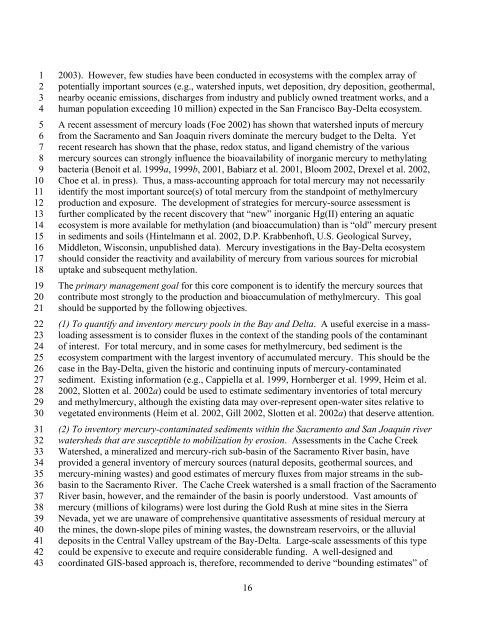Mercury Strategy for the Bay-Delta Ecosystem - CALFED Bay-Delta ...
Mercury Strategy for the Bay-Delta Ecosystem - CALFED Bay-Delta ...
Mercury Strategy for the Bay-Delta Ecosystem - CALFED Bay-Delta ...
Create successful ePaper yourself
Turn your PDF publications into a flip-book with our unique Google optimized e-Paper software.
1<br />
2<br />
3<br />
4<br />
5<br />
6<br />
7<br />
8<br />
9<br />
10<br />
11<br />
12<br />
13<br />
14<br />
15<br />
16<br />
17<br />
18<br />
19<br />
20<br />
21<br />
22<br />
23<br />
24<br />
25<br />
26<br />
27<br />
28<br />
29<br />
30<br />
31<br />
32<br />
33<br />
34<br />
35<br />
36<br />
37<br />
38<br />
39<br />
40<br />
41<br />
42<br />
43<br />
2003). However, few studies have been conducted in ecosystems with <strong>the</strong> complex array of<br />
potentially important sources (e.g., watershed inputs, wet deposition, dry deposition, geo<strong>the</strong>rmal,<br />
nearby oceanic emissions, discharges from industry and publicly owned treatment works, and a<br />
human population exceeding 10 million) expected in <strong>the</strong> San Francisco <strong>Bay</strong>-<strong>Delta</strong> ecosystem.<br />
A recent assessment of mercury loads (Foe 2002) has shown that watershed inputs of mercury<br />
from <strong>the</strong> Sacramento and San Joaquin rivers dominate <strong>the</strong> mercury budget to <strong>the</strong> <strong>Delta</strong>. Yet<br />
recent research has shown that <strong>the</strong> phase, redox status, and ligand chemistry of <strong>the</strong> various<br />
mercury sources can strongly influence <strong>the</strong> bioavailability of inorganic mercury to methylating<br />
bacteria (Benoit et al. 1999a, 1999b, 2001, Babiarz et al. 2001, Bloom 2002, Drexel et al. 2002,<br />
Choe et al. in press). Thus, a mass-accounting approach <strong>for</strong> total mercury may not necessarily<br />
identify <strong>the</strong> most important source(s) of total mercury from <strong>the</strong> standpoint of methylmercury<br />
production and exposure. The development of strategies <strong>for</strong> mercury-source assessment is<br />
fur<strong>the</strong>r complicated by <strong>the</strong> recent discovery that “new” inorganic Hg(II) entering an aquatic<br />
ecosystem is more available <strong>for</strong> methylation (and bioaccumulation) than is “old” mercury present<br />
in sediments and soils (Hintelmann et al. 2002, D.P. Krabbenhoft, U.S. Geological Survey,<br />
Middleton, Wisconsin, unpublished data). <strong>Mercury</strong> investigations in <strong>the</strong> <strong>Bay</strong>-<strong>Delta</strong> ecosystem<br />
should consider <strong>the</strong> reactivity and availability of mercury from various sources <strong>for</strong> microbial<br />
uptake and subsequent methylation.<br />
The primary management goal <strong>for</strong> this core component is to identify <strong>the</strong> mercury sources that<br />
contribute most strongly to <strong>the</strong> production and bioaccumulation of methylmercury. This goal<br />
should be supported by <strong>the</strong> following objectives.<br />
(1) To quantify and inventory mercury pools in <strong>the</strong> <strong>Bay</strong> and <strong>Delta</strong>. A useful exercise in a massloading<br />
assessment is to consider fluxes in <strong>the</strong> context of <strong>the</strong> standing pools of <strong>the</strong> contaminant<br />
of interest. For total mercury, and in some cases <strong>for</strong> methylmercury, bed sediment is <strong>the</strong><br />
ecosystem compartment with <strong>the</strong> largest inventory of accumulated mercury. This should be <strong>the</strong><br />
case in <strong>the</strong> <strong>Bay</strong>-<strong>Delta</strong>, given <strong>the</strong> historic and continuing inputs of mercury-contaminated<br />
sediment. Existing in<strong>for</strong>mation (e.g., Cappiella et al. 1999, Hornberger et al. 1999, Heim et al.<br />
2002, Slotten et al. 2002a) could be used to estimate sedimentary inventories of total mercury<br />
and methylmercury, although <strong>the</strong> existing data may over-represent open-water sites relative to<br />
vegetated environments (Heim et al. 2002, Gill 2002, Slotten et al. 2002a) that deserve attention.<br />
(2) To inventory mercury-contaminated sediments within <strong>the</strong> Sacramento and San Joaquin river<br />
watersheds that are susceptible to mobilization by erosion. Assessments in <strong>the</strong> Cache Creek<br />
Watershed, a mineralized and mercury-rich sub-basin of <strong>the</strong> Sacramento River basin, have<br />
provided a general inventory of mercury sources (natural deposits, geo<strong>the</strong>rmal sources, and<br />
mercury-mining wastes) and good estimates of mercury fluxes from major streams in <strong>the</strong> subbasin<br />
to <strong>the</strong> Sacramento River. The Cache Creek watershed is a small fraction of <strong>the</strong> Sacramento<br />
River basin, however, and <strong>the</strong> remainder of <strong>the</strong> basin is poorly understood. Vast amounts of<br />
mercury (millions of kilograms) were lost during <strong>the</strong> Gold Rush at mine sites in <strong>the</strong> Sierra<br />
Nevada, yet we are unaware of comprehensive quantitative assessments of residual mercury at<br />
<strong>the</strong> mines, <strong>the</strong> down-slope piles of mining wastes, <strong>the</strong> downstream reservoirs, or <strong>the</strong> alluvial<br />
deposits in <strong>the</strong> Central Valley upstream of <strong>the</strong> <strong>Bay</strong>-<strong>Delta</strong>. Large-scale assessments of this type<br />
could be expensive to execute and require considerable funding. A well-designed and<br />
coordinated GIS-based approach is, <strong>the</strong>re<strong>for</strong>e, recommended to derive “bounding estimates” of<br />
16

















